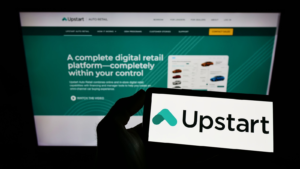Student loan repayments are rearing their ugly heads as borrowers prepare to start paying them back next week. After three years of blissful reprieve, borrowers are set to begin dedicating cash towards their burdensome debt loads. That cash flow requirement will begin cutting into household budgets as the national personal savings rate hits multi-decade lows and credit card debt hits all-time highs.
That is a recipe for disaster. Student loans are a perennial hot political topic, but widespread forgiveness doesn’t seem to be on the horizon. Instead, as 43.6 million borrowers hold $1.76 trillion in federal student loan debt, there’s a potential storm on the horizon.
And these three stocks stand to suffer the most.
SoFi Technologies (SOFI)

SoFi Technologies (NASDAQ:SOFI) built its name on lending and loan refinancing, but student loan repayments restarting isn’t the boon they likely hoped it would be. In March, the digital banking institution sued the federal government, claiming the pause was unlawful. I believe its reasoning was that fewer borrowers wanted to refinance existing loans if there was no pressing need to pay. While the lawsuit didn’t work, today’s high-interest rates mean SoFi isn’t in a viable position to refinance the loans anyway.
As borrowing costs increase, private lenders must raise their rates to match. They must also maintain the rate high enough to account for internal expenses like payroll and marketing. SoFi’s refinance rates range from 5.24% for a 5-year refinancing period to 9.59% for a 20-year option. The highest federal student loan rate, issued today, is 8.05% for graduate students as a Direct PLUS loan. However, many existing student loans are far below this rate, and the average for all borrowers is 5.8%. With a glut of new income-based repayment options that further cut interest payments, there’s little sense in refinancing with SoFi at its elevated rates. Ultimately, today’s economic climate puts SoFi’s planned bottom line at risk even as repayments begin.
Apple (AAPL)

Apple (NASDAQ:AAPL) is a favorite among younger, hip and tech-oriented consumers. Unfortunately, that’s also the core demographic holding student loans and preparing to pinch pennies. Education Data Initiative reported that 34% of adults between 18 and 29 hold student loans. That’s the same demographic buying about half of Apple iPhones, iPads, and Macs. With personal savings rates dwindling and credit card debt skyrocketing, consumers with student loan repayments simply won’t want to spend unneeded cash on luxury items — even those as popular as Apple’s.
We may already see the first waves of reduced demand for Apple products. The company’s revenue fell over the past two quarters, perhaps as consumers began bracing themselves to start paying student loans again. What the outcome will be is anyone’s guess, but Apple faces supply chain issues and partnership problems, so it can ill-afford losing consumer cash to the federal government.
Upstart Holdings (UPST)

Artificial intelligence-centric lender Upstart Holdings (NASDAQ:UPST) faces many of the same problems as SoFi, with a unique twist — it has long been on the losing side of market sentiment. While the company doesn’t explicitly refinance student loans, its personal loan offerings are an alternative. Those rates range from 5.2% to a whopping 35.99%. Again, with federal student loans averaging just under 6%, borrowers won’t likely knock down UPST’s door to refinance with less agreeable terms.
UPST has been losing recently, mostly exacerbated by high-interest rates and reduced demand. Revenue nearly halved in the past quarter, and management’s outlook wasn’t cheery. In an investor call, executives said they expect $140 million in revenue and $5 million in adjusted earnings. That’s a tough pill to swallow, and the stock fell hard after the early August announcement. But there’s still room for the stock to fall, and student loans won’t be UPST’s savior.
On the date of publication, Jeremy Flint did not hold (directly or indirectly) any positions in the securities mentioned in this article. The opinions expressed in this article are those of the writer, subject to the InvestorPlace.com Publishing Guidelines.
